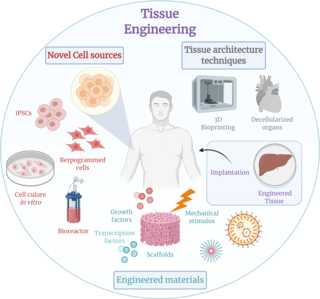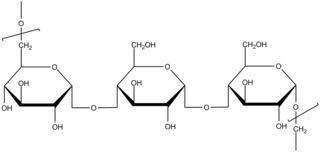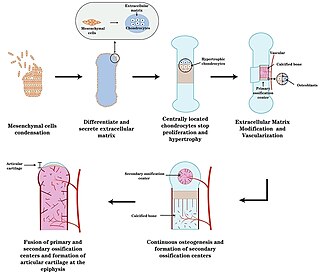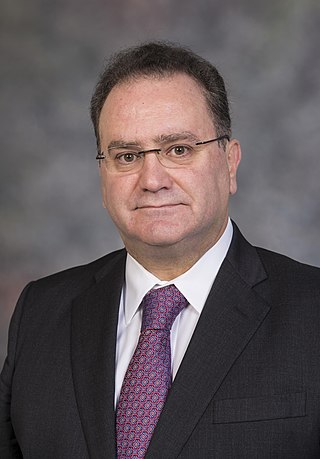Related Research Articles

Tissue engineering is a biomedical engineering discipline that uses a combination of cells, engineering, materials methods, and suitable biochemical and physicochemical factors to restore, maintain, improve, or replace different types of biological tissues. Tissue engineering often involves the use of cells placed on tissue scaffolds in the formation of new viable tissue for a medical purpose, but is not limited to applications involving cells and tissue scaffolds. While it was once categorized as a sub-field of biomaterials, having grown in scope and importance, it can is considered as a field of its own.

Pullulan is a polysaccharide polymer consisting of maltotriose units, also known as α-1,4- ;α-1,6-glucan'. Three glucose units in maltotriose are connected by an α-1,4 glycosidic bond, whereas consecutive maltotriose units are connected to each other by an α-1,6 glycosidic bond. Pullulan is produced from starch by the fungus Aureobasidium pullulans. Pullulan is mainly used by the cell to resist desiccation and predation. The presence of this polysaccharide also facilitates diffusion of molecules both into and out of the cell.

Endochondral ossification is one of the two essential pathways by which bone tissue is produced during fetal development of the mammalian skeletal system, the other pathway being intramembranous ossification. Both endochondral and intramembranous processes initiate from a precursor mesenchymal tissue, but their transformations into bone are different. In intramembranous ossification, mesenchymal tissue is directly converted into bone. On the other hand, endochondral ossification starts with mesenchymal tissue turning into an intermediate cartilage stage, which is eventually substituted by bone.
Articular cartilage, most notably that which is found in the knee joint, is generally characterized by very low friction, high wear resistance, and poor regenerative qualities. It is responsible for much of the compressive resistance and load bearing qualities of the knee joint and, without it, walking is painful to impossible. Osteoarthritis is a common condition of cartilage failure that can lead to limited range of motion, bone damage and invariably, pain. Due to a combination of acute stress and chronic fatigue, osteoarthritis directly manifests itself in a wearing away of the articular surface and, in extreme cases, bone can be exposed in the joint. Some additional examples of cartilage failure mechanisms include cellular matrix linkage rupture, chondrocyte protein synthesis inhibition, and chondrocyte apoptosis. There are several different repair options available for cartilage damage or failure.
Articular cartilage repair treatment involves the repair of the surface of the articular joint's hyaline cartilage, though these solutions do not perfectly restore the articular cartilage. These treatments have been shown to have positive results for patients who have articular cartilage damage. They can provide some measure of pain relief, while slowing down the accumulation of damage, or delaying the need for joint replacement surgery.
Autologous chondrocyte implantation is a biomedical treatment that repairs damages in articular cartilage. ACI provides pain relief while at the same time slowing down the progression or considerably delaying partial or total joint replacement surgery.

Clemens A. van Blitterswijk is a Dutch tissue engineer who contributed to the use of biomaterials to heal bone injuries, especially using osteoinductive ceramics. In collaboration with Jan de Boer and others, he has contributed to screening microtextures to study cell-biomaterial interactions, an approach termed materiomics.
Nano-scaffolding or nanoscaffolding is a medical process used to regrow tissue and bone, including limbs and organs. The nano-scaffold is a three-dimensional structure composed of polymer fibers very small that are scaled from a Nanometer scale. Developed by the American military, the medical technology uses a microscopic apparatus made of fine polymer fibers called a scaffold. Damaged cells grip to the scaffold and begin to rebuild missing bone and tissue through tiny holes in the scaffold. As tissue grows, the scaffold is absorbed into the body and disappears completely.
A fibrin scaffold is a network of protein that holds together and supports a variety of living tissues. It is produced naturally by the body after injury, but also can be engineered as a tissue substitute to speed healing. The scaffold consists of naturally occurring biomaterials composed of a cross-linked fibrin network and has a broad use in biomedical applications.

Arginylglycylaspartic acid (RGD) is the most common peptide motif responsible for cell adhesion to the extracellular matrix (ECM), found in species ranging from Drosophila to humans. Cell adhesion proteins called integrins recognize and bind to this sequence, which is found within many matrix proteins, including fibronectin, fibrinogen, vitronectin, osteopontin, and several other adhesive extracellular matrix proteins. The discovery of RGD and elucidation of how RGD binds to integrins has led to the development of a number of drugs and diagnostics, while the peptide itself is used ubiquitously in bioengineering. Depending on the application and the integrin targeted, RGD can be chemically modified or replaced by a similar peptide which promotes cell adhesion.

Gordana Vunjak-NovakovicFRSC is a Serbian American biomedical engineer and university professor. She is a University Professor at Columbia University, as well as the Mikati Foundation Professor of Biomedical Engineering and Medical Sciences. She also heads the laboratory for Stem Cells and Tissue Engineering at Columbia University. She is part of the faculty at the Irving Comprehensive Cancer Center and the Center for Human Development, both found at Columbia University. She is also an honorary professor at the Faculty of Technology and Metallurgy at the University of Belgrade, an honorary professor at the University of Novi Sad, and an adjunct professor at the Department of Biomedical Engineering at Tufts University.

Decellularization is the process used in biomedical engineering to isolate the extracellular matrix (ECM) of a tissue from its inhabiting cells, leaving an ECM scaffold of the original tissue, which can be used in artificial organ and tissue regeneration. Organ and tissue transplantation treat a variety of medical problems, ranging from end organ failure to cosmetic surgery. One of the greatest limitations to organ transplantation derives from organ rejection caused by antibodies of the transplant recipient reacting to donor antigens on cell surfaces within the donor organ. Because of unfavorable immune responses, transplant patients suffer a lifetime taking immunosuppressing medication. Stephen F. Badylak pioneered the process of decellularization at the McGowan Institute for Regenerative Medicine at the University of Pittsburgh. This process creates a natural biomaterial to act as a scaffold for cell growth, differentiation and tissue development. By recellularizing an ECM scaffold with a patient’s own cells, the adverse immune response is eliminated. Nowadays, commercially available ECM scaffolds are available for a wide variety of tissue engineering. Using peracetic acid to decellularize ECM scaffolds have been found to be false and only disinfects the tissue.
A 3D cell culture is an artificially created environment in which biological cells are permitted to grow or interact with their surroundings in all three dimensions. Unlike 2D environments, a 3D cell culture allows cells in vitro to grow in all directions, similar to how they would in vivo. These three-dimensional cultures are usually grown in bioreactors, small capsules in which the cells can grow into spheroids, or 3D cell colonies. Approximately 300 spheroids are usually cultured per bioreactor.
Treena Livingston Arinzeh is an American biomedical engineer and academic.

Antonios Georgios Mikos is a Greek-American biomedical engineer who is the Louis Calder Professor of Bioengineering and Chemical and Biomolecular Engineering at Rice University. He specialises in biomaterials, drug delivery, and tissue engineering.
Nasal chondrocytes (NC) are present in the hyaline cartilage of the nasal septum and in fact are the only cell type within the tissue. Similar to chondrocytes present in articular cartilage, NC express extracellular matrix proteins such as glycosaminoglycans and collagen.
Tissue engineered heart valves (TEHV) offer a new and advancing proposed treatment of creating a living heart valve for people who are in need of either a full or partial heart valve replacement. Currently, there are over a quarter of a million prosthetic heart valves implanted annually, and the number of patients requiring replacement surgeries is only suspected to rise and even triple over the next fifty years. While current treatments offered such as mechanical valves or biological valves are not deleterious to one's health, they both have their own limitations in that mechanical valves necessitate the lifelong use of anticoagulants while biological valves are susceptible to structural degradation and reoperation. Thus, in situ (in its original position or place) tissue engineering of heart valves serves as a novel approach that explores the use creating a living heart valve composed of the host's own cells that is capable of growing, adapting, and interacting within the human body's biological system.
Sarah Harriet Cartmell is a British biomaterials scientist and Professor of Bioengineering at the University of Manchester. She specializes on the potential use of electrical regimes to influence cellular activity for orthopaedic tissue engineering applications.
Craniofacial regeneration refers to the biological process by which the skull and face regrow to heal an injury. This page covers birth defects and injuries related to the craniofacial region, the mechanisms behind the regeneration, the medical application of these processes, and the scientific research conducted on this specific regeneration. This regeneration is not to be confused with tooth regeneration. Craniofacial regrowth is broadly related to the mechanisms of general bone healing.
Thomas J. Webster is an American biomedical engineer, researcher, and entrepreneur. Throughout his over 25-year academic career, his research group has produced several books and book chapters. He has over 1350 publications and has an H-index of 118. This high H-index places him amongst the top 1% of researchers in his field.
References
- ↑ Dusseldorp, Joseph Richard; Mobbs, Ralph J. (September 2009). "Iliac crest reconstruction to reduce donor-site morbidity: technical note". European Spine Journal. 18 (9): 1386–90. doi:10.1007/s00586-009-1108-4. PMC 2899541 . PMID 19653014.
- 1 2 Sladkova, Martina; de Peppo, Giuseppe (2014-06-11). "Bioreactor Systems for Human Bone Tissue Engineering". Processes. 2 (2): 494–525. doi: 10.3390/pr2020494 . ISSN 2227-9717.
- ↑ Ikada, Yoshito (2006-10-22). "Challenges in tissue engineering". Journal of the Royal Society Interface. 3 (10): 589–601. doi:10.1098/rsif.2006.0124. PMC 1664655 . PMID 16971328.
- ↑ Oragui, Emeka; Nannaparaju, Madhusudhan; Khan, Wasim S. (2011). "Suppl 2: The Role of Bioreactors in Tissue Engineering for Musculoskeletal Applications". The Open Orthopaedics Journal. 5: 267–70. doi: 10.2174/1874325001105010267 . PMC 3149843 . PMID 21886691.
- ↑ Badylak, Stephen F.; Nerem, Robert M. (2010-02-23). "Progress in tissue engineering and regenerative medicine". Proceedings of the National Academy of Sciences. 107 (8): 3285–3286. doi: 10.1073/pnas.1000256107 . ISSN 0027-8424. PMC 2840480 . PMID 20181571.
- 1 2 Holt, Ginger E.; Halpern, Jennifer L.; Dovan, Thomas T.; Hamming, David; Schwartz, Herbert S. (2005). "Evolution of an in vivo bioreactor". Journal of Orthopaedic Research. 23 (4): 916–923. doi: 10.1016/j.orthres.2004.10.005 . ISSN 1554-527X. PMID 16023008. S2CID 44717897.
- 1 2 Stevens, M. M.; Marini, R. P.; Schaefer, D.; Aronson, J.; Langer, R.; Shastri, V. P. (2005-07-29). "In vivo engineering of organs: The bone bioreactor". Proceedings of the National Academy of Sciences. 102 (32): 11450–11455. Bibcode:2005PNAS..10211450S. doi: 10.1073/pnas.0504705102 . ISSN 0027-8424. PMC 1183576 . PMID 16055556.
- ↑ Moya, Monica L.; Cheng, Ming-Huei; Huang, Jung-Ju; Francis-Sedlak, Megan E.; Kao, Shu-wei; Opara, Emmanuel C.; Brey, Eric M. (April 2010). "The effect of FGF-1 loaded alginate microbeads on neovascularization and adipogenesis in a vascular pedicle model of adipose tissue engineering". Biomaterials. 31 (10): 2816–2826. doi:10.1016/j.biomaterials.2009.12.053. ISSN 0142-9612. PMC 2826798 . PMID 20080298.
- ↑ Scime, Anthony (2009). "Advances in myogenic cell transplantation and skeletal muscle tissue engineering". Frontiers in Bioscience. 14 (14): 3012–23. doi: 10.2741/3431 . ISSN 1093-9946. PMID 19273253.
- ↑ Stillaert, F.B.; Di Bartolo, C.; Hunt, J.A.; Rhodes, N.P.; Tognana, E.; Monstrey, S.; Blondeel, P.N. (October 2008). "Human clinical experience with adipose precursor cells seeded on hyaluronic acid-based spongy scaffolds". Biomaterials. 29 (29): 3953–3959. doi:10.1016/j.biomaterials.2008.06.005. hdl: 1854/LU-433440 . ISSN 0142-9612. PMID 18635258.
- 1 2 McCullen, Seth D; Chow, Andre GY; Stevens, Molly M (2011-10-01). "In vivo tissue engineering of musculoskeletal tissues". Current Opinion in Biotechnology. Tissue, cell and pathway engineering. 22 (5): 715–720. doi:10.1016/j.copbio.2011.05.001. ISSN 0958-1669. PMID 21646011.
- ↑ Fong, Eliza L.S.; Chan, Casey K.; Goodman, Stuart B. (January 2011). "Stem cell homing in musculoskeletal injury". Biomaterials. 32 (2): 395–409. doi:10.1016/j.biomaterials.2010.08.101. ISSN 0142-9612. PMC 2991369 . PMID 20933277.
- ↑ da Silva Meirelles, Lindolfo; Caplan, Arnold I.; Nardi, Nance Beyer (September 2008). "In Search of the In Vivo Identity of Mesenchymal Stem Cells". Stem Cells. 26 (9): 2287–2299. doi: 10.1634/stemcells.2007-1122 . ISSN 1066-5099. PMID 18566331. S2CID 5908295.
- ↑ Chen, Liwen; Tredget, Edward E.; Wu, Philip Y. G.; Wu, Yaojiong (2008-04-02). "Paracrine Factors of Mesenchymal Stem Cells Recruit Macrophages and Endothelial Lineage Cells and Enhance Wound Healing". PLOS ONE. 3 (4): e1886. Bibcode:2008PLoSO...3.1886C. doi: 10.1371/journal.pone.0001886 . ISSN 1932-6203. PMC 2270908 . PMID 18382669.
- ↑ Shastri, V. Prasad (2009-11-06). "In vivo Engineering of Tissues: Biological Considerations, Challenges, Strategies, and Future Directions". Advanced Materials. 21 (41): 3246–54. Bibcode:2009AdM....2190155S. doi: 10.1002/adma.200990155 . ISSN 0935-9648. PMID 20882495.
- ↑ Place, Elsie S.; Evans, Nicholas D.; Stevens, Molly M. (June 2009). "Complexity in biomaterials for tissue engineering". Nature Materials. 8 (6): 457–470. Bibcode:2009NatMa...8..457P. doi:10.1038/nmat2441. ISSN 1476-1122. PMID 19458646.
- ↑ Zhu, Junmin (June 2010). "Bioactive modification of poly(ethylene glycol) hydrogels for tissue engineering". Biomaterials. 31 (17): 4639–4656. doi:10.1016/j.biomaterials.2010.02.044. ISSN 0142-9612. PMC 2907908 . PMID 20303169.
- ↑ MUSCHLER, GEORGE F.; NAKAMOTO, CHIZU; GRIFFITH, LINDA G. (July 2004). "Engineering Principles of Clinical Cell-Based Tissue Engineering". The Journal of Bone and Joint Surgery, American Volume. 86 (7): 1541–1558. doi:10.2106/00004623-200407000-00029. ISSN 0021-9355. PMID 15252108.
- ↑ Prendergast, P.J.; Huiskes, R.; Søballe, K. (June 1997). "Biophysical stimuli on cells during tissue differentiation at implant interfaces". Journal of Biomechanics. 30 (6): 539–548. doi:10.1016/s0021-9290(96)00140-6. hdl: 2066/25371 . ISSN 0021-9290. PMID 9165386. S2CID 28681922.
- 1 2 Oragui, Emeka; Nannaparaju, Madhusudhan; Khan, Wasim S (2011-07-28). "The Role of Bioreactors in Tissue Engineering for Musculoskeletal Applications". The Open Orthopaedics Journal. 5: 267–270. doi: 10.2174/1874325001105010267 . ISSN 1874-3250. PMC 3149843 . PMID 21886691.
- ↑ Thevenot, Paul T.; Nair, Ashwin M.; Shen, Jinhui; Lotfi, Parisa; Ko, Cheng-Yu; Tang, Liping (May 2010). "The effect of incorporation of SDF-1α into PLGA scaffolds on stem cell recruitment and the inflammatory response". Biomaterials. 31 (14): 3997–4008. doi:10.1016/j.biomaterials.2010.01.144. ISSN 0142-9612. PMC 2838969 . PMID 20185171.
- ↑ Shen, Weiliang; Chen, Xiao; Chen, Jialin; Yin, Zi; Heng, Boon Chin; Chen, Weishan; Ouyang, Hong-Wei (October 2010). "The effect of incorporation of exogenous stromal cell-derived factor-1 alpha within a knitted silk-collagen sponge scaffold on tendon regeneration". Biomaterials. 31 (28): 7239–7249. doi:10.1016/j.biomaterials.2010.05.040. ISSN 0142-9612. PMID 20615544.
- ↑ BADYLAK, S; FREYTES, D; GILBERT, T (January 2009). "Extracellular matrix as a biological scaffold material: Structure and function". Acta Biomaterialia. 5 (1): 1–13. doi:10.1016/j.actbio.2008.09.013. ISSN 1742-7061. PMID 18938117.
- ↑ Zhang, Shuming; Greenfield, Megan A.; Mata, Alvaro; Palmer, Liam C.; Bitton, Ronit; Mantei, Jason R.; Aparicio, Conrado; de la Cruz, Monica Olvera; Stupp, Samuel I. (2010-06-13). "A self-assembly pathway to aligned monodomain gels". Nature Materials. 9 (7): 594–601. Bibcode:2010NatMa...9..594Z. doi:10.1038/nmat2778. ISSN 1476-1122. PMC 3084632 . PMID 20543836.
- ↑ "Supramolecular GAG-like Self-Assembled Glycopeptide Nanofibers Induce Chondrogenesis and Cartilage Regeneration". doi: 10.1021/acs.biomac.5b01669.s001 .
{{cite journal}}: Cite journal requires|journal=(help) - ↑ "PB33 Autologous in vitro cartilage. Engineering, characterization, application". Osteoarthritis and Cartilage. 9: S53–S54. September 2001. doi: 10.1016/s1063-4584(01)80358-7 . ISSN 1063-4584.
- 1 2 3 4 Yap, Kiryu K.; Yeoh, George C.; Morrison, Wayne A.; Mitchell, Geraldine M. (2018-10-01). "The Vascularised Chamber as an In Vivo Bioreactor". Trends in Biotechnology. 36 (10): 1011–1024. doi:10.1016/j.tibtech.2018.05.009. ISSN 0167-7799. PMID 29937050. S2CID 49407121.
- ↑ Zhang, Haifeng; Mao, Xiyuan; Zhao, Danyang; Jiang, Wenbo; Du, Zijing; Li, Qingfeng; Jiang, Chaohua; Han, Dong (2017-11-10). "Three dimensional printed polylactic acid-hydroxyapatite composite scaffolds for prefabricating vascularized tissue engineered bone: An in vivo bioreactor model". Scientific Reports. 7 (1): 15255. Bibcode:2017NatSR...715255Z. doi:10.1038/s41598-017-14923-7. ISSN 2045-2322. PMC 5681514 . PMID 29127293.
- ↑ Lokmic, Zerina; Stillaert, Filip; Morrison, Wayne A.; Thompson, Erik W.; Mitchell, Geraldine M. (February 2007). "An arteriovenous loop in a protected space generates a permanent, highly vascular, tissue-engineered construct". FASEB Journal. 21 (2): 511–522. doi: 10.1096/fj.06-6614com . hdl: 1854/LU-742572 . ISSN 1530-6860. PMID 17172640. S2CID 22730132.
- ↑ Tatara, Alexander M.; Koons, Gerry L.; Watson, Emma; Piepergerdes, Trenton C.; Shah, Sarita R.; Smith, Brandon T.; Shum, Jonathan; Melville, James C.; Hanna, Issa A.; Demian, Nagi; Ho, Tang (2019-04-02). "Biomaterials-aided mandibular reconstruction using in vivo bioreactors". Proceedings of the National Academy of Sciences. 116 (14): 6954–6963. Bibcode:2019PNAS..116.6954T. doi: 10.1073/pnas.1819246116 . ISSN 0027-8424. PMC 6452741 . PMID 30886100.
- ↑ Baumert, Hervé; Simon, Pascal; Hekmati, Mehrak; Fromont, Gaëlle; Levy, Maryline; Balaton, André; Molinié, Vincent; Malavaud, Bernard (2007-09-01). "Development of a Seeded Scaffold in the Great Omentum: Feasibility of an in vivo Bioreactor for Bladder Tissue Engineering". European Urology. 52 (3): 884–892. doi:10.1016/j.eururo.2006.11.044. ISSN 0302-2838. PMID 17229515.
- ↑ Stevens, Molly M.; Marini, Robert P.; Schaefer, Dirk; Aronson, Joshua; Langer, Robert; Shastri, V. Prasad (June 8, 2005). "In vivo engineering of organs: The bone bioreactor". Proceedings of the National Academy of Sciences, USA. 102 (32): 11450–11455. Bibcode:2005PNAS..10211450S. doi: 10.1073/pnas.0504705102 . PMC 1183576 . PMID 16055556.
- ↑ Service, Robert F. (29 July 2005). "Technique Uses Body as 'Bioreactor' to Grow New Bone". Science. 309 (5735): 683. doi:10.1126/science.309.5735.683a. PMID 16051759. S2CID 42416342.
- ↑ Marini, Robert P.; Stevens, Molly M.; Langer, Robert; Shastri, V. Prasad (2004). "Hydraulic Elevation of the Periosteum: A Novel Technique for Periosteal Harvest". Journal of Investigative Surgery. 17 (4): 229–233. doi:10.1080/08941930490472073. PMID 15371165. S2CID 20122007.
- ↑ Emans, Pieter J.; Lodewijk W. van Rhijn; Welting, Tim J. M.; Cremers, Andy; Wijnands, Nina; Spaapen, Frank; J. Voncken, Willem; Shastri, V. Prasad (January 7, 2010). "Autologous engineering of cartilage". Proceedings of the National Academy of Sciences, USA. 107 (8): 3418–3423. Bibcode:2010PNAS..107.3418E. doi: 10.1073/pnas.0907774107 . PMC 2840469 . PMID 20133690.